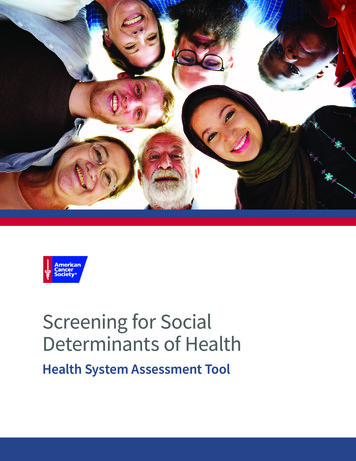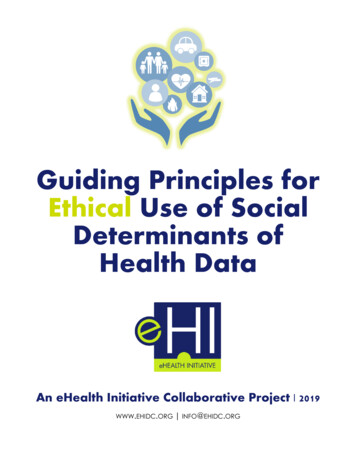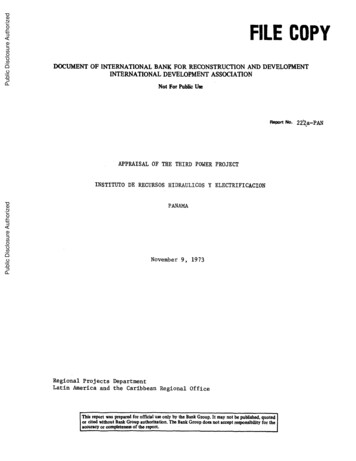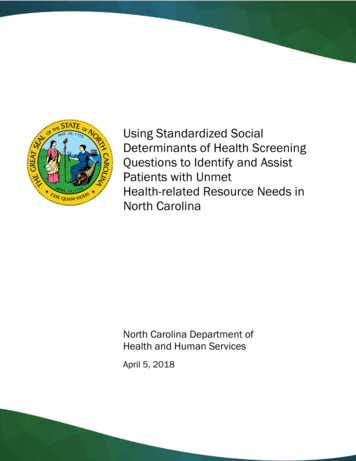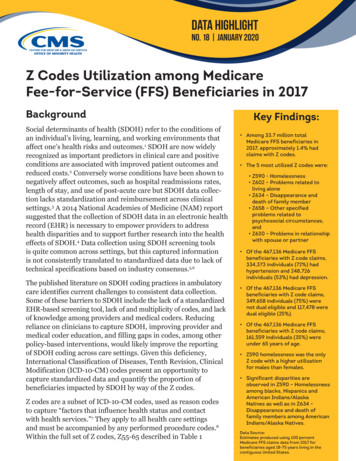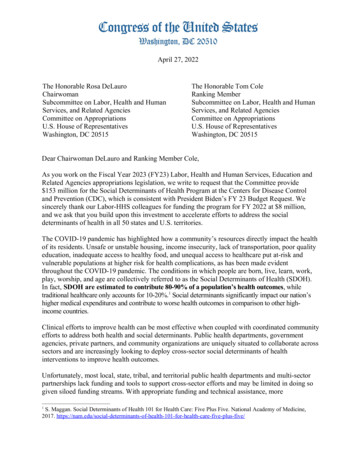
Transcription
April 27, 2022The Honorable Rosa DeLauroChairwomanSubcommittee on Labor, Health and HumanServices, and Related AgenciesCommittee on AppropriationsU.S. House of RepresentativesWashington, DC 20515The Honorable Tom ColeRanking MemberSubcommittee on Labor, Health and HumanServices, and Related AgenciesCommittee on AppropriationsU.S. House of RepresentativesWashington, DC 20515Dear Chairwoman DeLauro and Ranking Member Cole,As you work on the Fiscal Year 2023 (FY23) Labor, Health and Human Services, Education andRelated Agencies appropriations legislation, we write to request that the Committee provide 153 million for the Social Determinants of Health Program at the Centers for Disease Controland Prevention (CDC), which is consistent with President Biden’s FY 23 Budget Request. Wesincerely thank our Labor-HHS colleagues for funding the program for FY 2022 at 8 million,and we ask that you build upon this investment to accelerate efforts to address the socialdeterminants of health in all 50 states and U.S. territories.The COVID-19 pandemic has highlighted how a community’s resources directly impact the healthof its residents. Unsafe or unstable housing, income insecurity, lack of transportation, poor qualityeducation, inadequate access to healthy food, and unequal access to healthcare put at-risk andvulnerable populations at higher risk for health complications, as has been made evidentthroughout the COVID-19 pandemic. The conditions in which people are born, live, learn, work,play, worship, and age are collectively referred to as the Social Determinants of Health (SDOH).In fact, SDOH are estimated to contribute 80-90% of a population’s health outcomes, whiletraditional healthcare only accounts for 10-20%.1 Social determinants significantly impact our nation’shigher medical expenditures and contribute to worse health outcomes in comparison to other highincome countries.Clinical efforts to improve health can be most effective when coupled with coordinated communityefforts to address both health and social determinants. Public health departments, governmentagencies, private partners, and community organizations are uniquely situated to collaborate acrosssectors and are increasingly looking to deploy cross-sector social determinants of healthinterventions to improve health outcomes.Unfortunately, most local, state, tribal, and territorial public health departments and multi-sectorpartnerships lack funding and tools to support cross-sector efforts and may be limited in doing sogiven siloed funding streams. With appropriate funding and technical assistance, moreS. Maggan. Social Determinants of Health 101 for Health Care: Five Plus Five. National Academy of Medicine,2017. for-health-care-five-plus-five/1
Page 2communities could engage in opportunities to identify SDOH priorities, ensure effective use ofresources and program flexibilities, and address barriers to health.CDC’s SDOH program was funded for the first time in FY2021. With 3 million, CDC funded20 jurisdictions to develop Social Determinants of Health Accelerator Plans that employedproven actions to address SDOH and combat negative social determinants of health.2 The grantswere awarded to state, local, and tribal entities that represent rural, urban, and tribal communitiesand accelerated actions that prevent and reduce chronic diseases among people experiencinghealth disparities. The House FY22 Labor-HHS, also in FY21, included language to create aninteragency Social Determinants Council. This interagency-intergovernmental Council wouldadvise and provide expertise on the development of Accelerator plans to State, local, and tribaljurisdictions in addition to developing a report on federal cross-agency opportunities to addresssocial determinants of health. The interagency Council is a critical component towardsimproving how the federal government looks to approach social determinants of health. We lookforward to working with the Committee on initiating the work of the Council.To build the evidence base for future SDOH work, CDC has also evaluated existing multisectorcoalitions that are working to advance SDOH-centered solutions. CDC found that 90% of themultisector partnerships evaluated contributed to community changes that promote healthyliving, and their programs are projected to save 566 million in medical and productivity costsover 20 years.3A healthier, more resilient population and stronger economy requires us to prevent and controlhealth conditions that raise health care costs and put lives at risk. By funding CDC’s SDOHprogram at 153 million, all 50 states and the territories would be empowered to partner withprivate, public, and non-profit partners to create community-centered solutions to address SDOHissues and reduce health disparities.Thank you for your leadership in crafting this important appropriations bill and for yourconsideration of this request.Sincerely,Nanette Diaz BarragánMember of CongressCheri BustosMember of CongressSocial Determinants of Health Accelerator Plans CDCCenters for Disease Control and Prevention. Improving Social Determinants ofHealth—Getting Further Faster. 2022. /sdoh/pdf/GFF-evalbrief-508.pdf23
Page 3G. K. ButterfieldMember of CongressTed DeutchMember of CongressYvette D. ClarkeMember of CongressJamie RaskinMember of CongressJoseph D. MorelleMember of CongressKatie PorterMember of CongressBrian HigginsMember of CongressBarbara LeeMember of CongressTony CárdenasMember of CongressBobby L. RushMember of Congress
Page 4Grace F. NapolitanoMember of CongressDoris MatsuiMember of CongressAl LawsonMember of CongressAlan LowenthalMember of CongressAbigail Davis SpanbergerMember of CongressDiana DeGetteMember of CongressCori BushMember of CongressEmanuel Cleaver, IIMember of CongressDanny K. DavisMember of CongressRashida TlaibMember of Congress
Page 5Jan SchakowskyMember of CongressJohn YarmuthMember of CongressLori TrahanMember of CongressJahana HayesMember of CongressTerri A. SewellMember of CongressAndré CarsonMember of CongressTroy CarterMember of CongressSalud CarbajalMember of CongressBradley Scott SchneiderMember of CongressPramila JayapalMember of Congress
Page 6Scott H. PetersMember of CongressAl GreenMember of CongressEleanor Holmes NortonMember of CongressSteven HorsfordMember of CongressPeter WelchMember of CongressLisa Blunt RochesterMember of CongressDwight EvansMember of CongressWilliam R. KeatingMember of CongressTed W. LieuMember of CongressNikema WilliamsMember of Congress
Page 7Lucy McBathMember of CongressRitchie TorresMember of CongressDavid N. CicillineMember of CongressA. Donald McEachinMember of CongressJamaal Bowman, Ed.D.Member of CongressJimmy PanettaMember of CongressIlhan OmarMember of CongressAlbio SiresMember of CongressJesús G. "Chuy" GarcíaMember of CongressMarilyn StricklandMember of Congress
brief-508.pdf Page 2. G. K. Butterfield Member of Congress Ted Deutch Member of Congress Yvette D. Clarke Member of Congress Jamie Raskin Member of Congress Joseph D. Morelle . Eleanor Holmes Norton Member of Congress Steven Horsford Member of Congress Peter Welch Member of Congress Lisa Blunt Rochester Member of Congress Dwight Evans Member .
